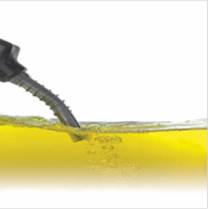Fuel Line

Fuelling GrowthFound on every vehicle, regardless of age or fuel type, the fuel pump is an essential automotive component. Cambiare provides an overview.
Up until the late 1980s, all fuel pumps were mechanical. This all changed with the introduction of electronic fuel-injected engines. These engines operate at higher pressures and require more sophisticated injection strategies than mechanical pumps can supply. ELECTRONIC FUEL PUMPS Mechanical fuel pumps are driven from a cam or lever driven by the engine. Electronic fuel pumps are powered by the alternator which is also driven by the engine. Electronic pumps can be balanced to match engine demand and therefore use less energy. The pump works very hard, circulating up to 44 gallons of fuel per hour (200L/hour) at pressures up to 3.5 bar (50 psi). The systems is run by a DC motor which produces heat, so positioning the pump inside the tank or along the fuel line ensures that it is constantly flooded with fuel, helping to lubricate the moving parts and cool the motor to prevent overheating. There are two types of electronic fuel pump on the market: in-line and in-tank. In-line fuel pumps are installed in the fuel line, after the fuel tank. In-tank systems are located inside the fuel tank and incorporate the fuel level gauge as an integral part of the pump. In-tank pumps are by far the most common type of system. Of course, this only works if the fuel level is maintained. If the fuel level is too low, the pump has to work much harder to produce the high pressure that the injection system requires. There is also less fuel to cool and lubricate the pump. Even running on low fuel can accelerate the wear of the pump. MECHANICAL FUEL PUMPS The primary reason that mechanical fuel pumps are not used in modern engines is to do with pressure and flow rate (volume). Driven by the camshaft, the mechanical pump is usually fixed to the engine block and uses the power of the engine to drive the pump. This delivers fuel to the carburettor at low pressure – around 0.2-0.3 bar (3-5 psi). It is the lack of pressure that makes mechanical fuel pumps unsuitable for today’s high pressure systems. The demise of the carburetted engine means that mechanical fuel pumps are now only found on older vehicles, predominantly pre-1995. This is therefore a shrinking, though by no means insignificant, section of the car parc. As a result, the OE manufacturers have largely pulled out of this market
FUEL PUMP FAILURE The primary cause of fuel pump failure is contamination caused by water or dirt particles in the fuel. Many electric pumps incorporate a pre-filter to prevent dirt ingress. But if the filter becomes clogged, the pump will quickly over heat as it will not receive the necessary lubrication or cooling it needs from the fuel. If the pre-filter is defective or missing, debris can enter the pump, slowly accumulating inside. This can restrict the moving parts until they no longer function, causing the pump to fail. Another element that can damage the fuel pump is the presence of water in fuel. If water enters the pump it can damage the electrical parts. Over time water will rust the interior of the fuel tank. Another element is high concentrations of bio fuel that can coat moving components. Due to the high pressure and volume requirements of the pumps, manufacturing tolerances are extremely fine. Particles as little as 10 microns (0.01mm) can cause scratches and scoring that destroy the internal system components. The pump itself is a non-serviceable part, so damage to any of the internal system components will require the replacement of the entire unit. Attempting to fix a fuel pump could lead to contaminants entering the fuel system, leading to further costly engine repairs. It is good general practice to fit a new fuel filter when replacing the fuel pump – this will help to preserve the integrity of the whole system. A damaged fuel pump may exhibit symptoms such as engine warning light illumination and vehicle start-up failure. Drivers may also experience poor fuel economy as the pump isn’t supplying the optimum level of fuel to the injectors which can also lead to irregular idling. CAMBIARE FUEL PUMP RANGE Cambiare’s new range of fuel pumps is composed of mechanical and electrical units, covering not only the latest applications but also the grey tail. Each part is supplied with comprehensive fitting instructions and all the relevant fittings, such as strainers, gaskets, hose clamps, washers, plug & connecting wires, sleeves and connecting rubber hoses where required. Cambiare fuel pumps are supported by a 2 year or 30,000 mile warranty
|
Related Articles Related Downloads |
